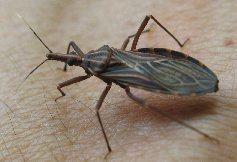Subfamily Triatominae Rank Species | Higher classification Rhodnius | |
 | ||
Similar Rhodnius, Kissing bugs, Insect, Triatoma, Triatoma infestans | ||
Effect of trypanosome infection on rhodnius prolixus survival
Rhodnius prolixus is the second most important triatomine vector of the Chagas parasite due to both its sylvatic and domestic populations in northern South America as well as to its exclusively domestic populations in Central America. It has a wide range of ecotopes, mainly savanna and foothills with an altitude of between 500 meters to 1,500 meters (1600 feet to 4,900 feet) above sea level and temperatures of 16 °C to 28 °C (61 °F to 82 °F). Sylvatic R. prolixus, as virtually all Rhodnius spp., is primarily associated with palm tree habitats and has a wide range of hosts including birds, rodents, marsupials, sloths, and reptiles.
Contents
- Effect of trypanosome infection on rhodnius prolixus survival
- Rhodnius prolixus ecdysis
- As disease vector
- References
The insect was used by Sir Vincent Wigglesworth for the detection of insect hormones. It has been implicated in the transmission of transposons between it and some of its vertebrate hosts, squirrel monkeys and opossums.
Rhodnius prolixus is also known as the kissing bug because it tends to feed on the area around victims' mouths.
Rhodnius prolixus ecdysis
As disease vector
Chagas disease is caused by the parasitic protozoan Trypanosoma cruzi. Infection with Chagas disease occurs after Rhodnius releases protozoans in its feces immediately following a blood meal. The parasite enters the victim through the bite wound after the human host scratches the bite. Infection may also occur via blood transfusion and ingestion of food contaminated with kissing bug feces.
